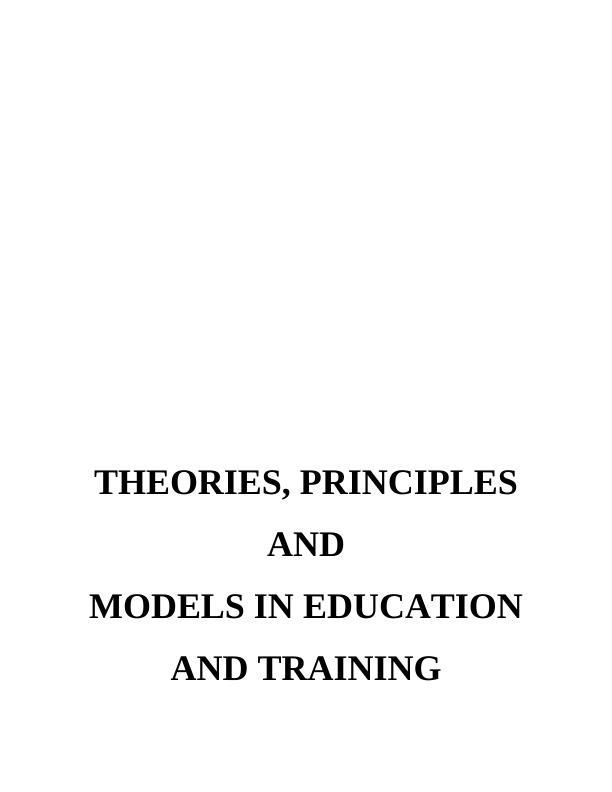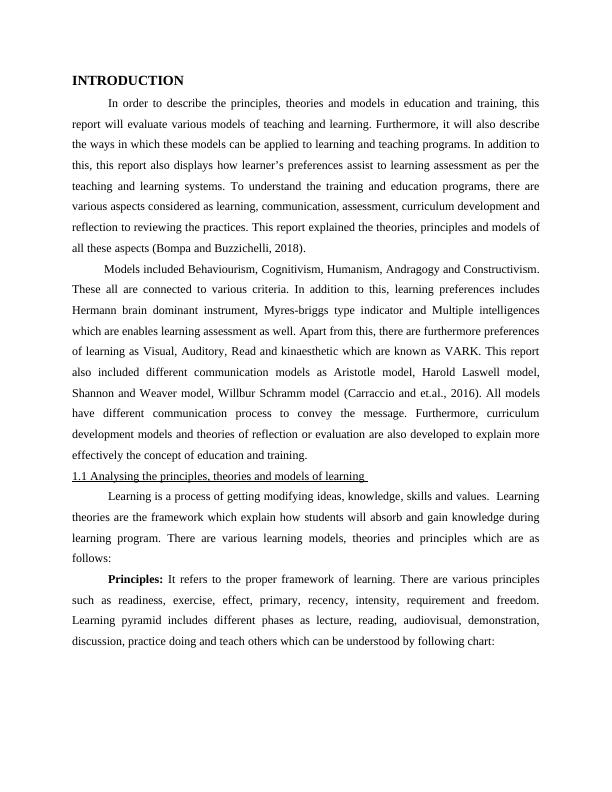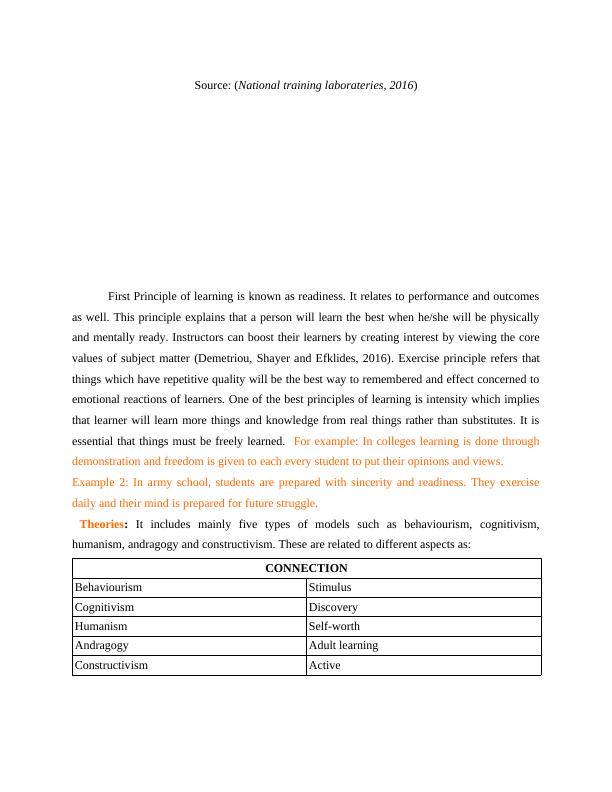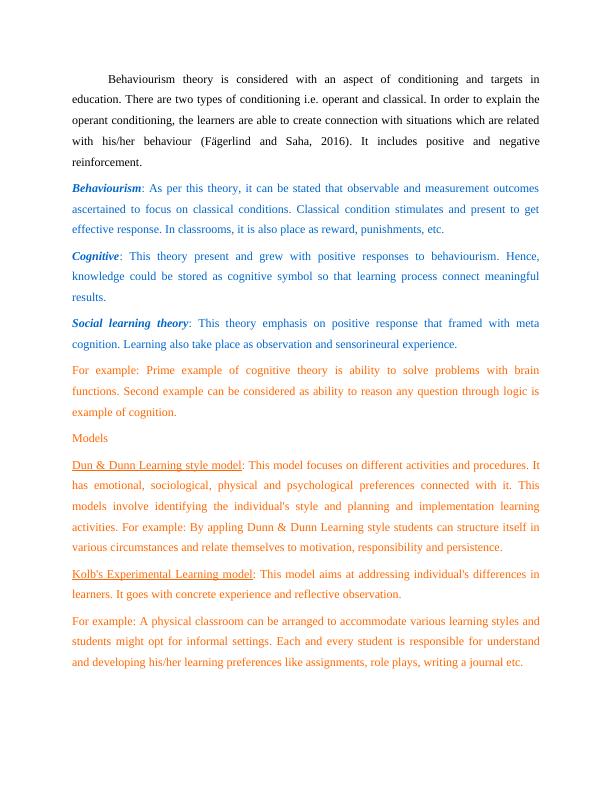Ask a question from expert
Theories, Principles and Models in Education and Training : Assignment
25 Pages6968 Words493 Views
Added on 2020-10-23
Theories, Principles and Models in Education and Training : Assignment
Added on 2020-10-23
BookmarkShareRelated Documents
THEORIES, PRINCIPLESANDMODELS IN EDUCATIONAND TRAINING

TABLE OF CONTENTSINTRODUCTION ..........................................................................................................................41.1 Analysing the principles, theories and models of learning ..................................................41.2 Describe ways in which theories and models of learning can be applied to learning ..........61.3 Analyse the models of learning preferences ........................................................................71.4 Explain how learning preferences enables learning assessment ..........................................82.1 Analyse models and theories of communication .................................................................92.2 Describe the ways in which models can be applied to learning and teaching assessment .113.1 Evaluate the theories, principles and models of assessment ..............................................123.2 Explain the ways in which theories can be applied to learning and teaching assessment .144.1 Evaluate the Theories and models of curriculum and development .................................144.2 Explain the theories and models of curriculum development in curriculum specialisation....................................................................................................................................................155.1 Evaluate the theories and models of reflection and evaluation ..........................................165.2 Explain the ways in which theories can be applied to reviewing own practice .................17CONCLUSION..............................................................................................................................18REFERENCES .............................................................................................................................20

Illustration IndexIllustration 1: Principles of learning................................................................................................6Illustration 2: Models of learning....................................................................................................7Illustration 3: Learning styles..........................................................................................................8Illustration 4: Principles of assessment .........................................................................................13Illustration 5: Gibbs reflective model ...........................................................................................18

INTRODUCTION In order to describe the principles, theories and models in education and training, thisreport will evaluate various models of teaching and learning. Furthermore, it will also describethe ways in which these models can be applied to learning and teaching programs. In addition tothis, this report also displays how learner’s preferences assist to learning assessment as per theteaching and learning systems. To understand the training and education programs, there arevarious aspects considered as learning, communication, assessment, curriculum development andreflection to reviewing the practices. This report explained the theories, principles and models ofall these aspects (Bompa and Buzzichelli, 2018).Models included Behaviourism, Cognitivism, Humanism, Andragogy and Constructivism.These all are connected to various criteria. In addition to this, learning preferences includesHermann brain dominant instrument, Myres-briggs type indicator and Multiple intelligenceswhich are enables learning assessment as well. Apart from this, there are furthermore preferencesof learning as Visual, Auditory, Read and kinaesthetic which are known as VARK. This reportalso included different communication models as Aristotle model, Harold Laswell model,Shannon and Weaver model, Willbur Schramm model (Carraccio and et.al., 2016). All modelshave different communication process to convey the message. Furthermore, curriculumdevelopment models and theories of reflection or evaluation are also developed to explain moreeffectively the concept of education and training. 1.1 Analysing the principles, theories and models of learning Learning is a process of getting modifying ideas, knowledge, skills and values. Learningtheories are the framework which explain how students will absorb and gain knowledge duringlearning program. There are various learning models, theories and principles which are asfollows: Principles: It refers to the proper framework of learning. There are various principlessuch as readiness, exercise, effect, primary, recency, intensity, requirement and freedom.Learning pyramid includes different phases as lecture, reading, audiovisual, demonstration,discussion, practice doing and teach others which can be understood by following chart:

First Principle of learning is known as readiness. It relates to performance and outcomesas well. This principle explains that a person will learn the best when he/she will be physicallyand mentally ready. Instructors can boost their learners by creating interest by viewing the corevalues of subject matter (Demetriou, Shayer and Efklides, 2016). Exercise principle refers thatthings which have repetitive quality will be the best way to remembered and effect concerned toemotional reactions of learners. One of the best principles of learning is intensity which impliesthat learner will learn more things and knowledge from real things rather than substitutes. It isessential that things must be freely learned. For example: In colleges learning is done throughdemonstration and freedom is given to each every student to put their opinions and views. Example 2: In army school, students are prepared with sincerity and readiness. They exercisedaily and their mind is prepared for future struggle.Theories: It includes mainly five types of models such as behaviourism, cognitivism,humanism, andragogy and constructivism. These are related to different aspects as:CONNECTION BehaviourismStimulus CognitivismDiscoveryHumanismSelf-worth Andragogy Adult learningConstructivismActive Source: (National training laborateries, 2016)

Behaviourism theory is considered with an aspect of conditioning and targets ineducation. There are two types of conditioning i.e. operant and classical. In order to explain theoperant conditioning, the learners are able to create connection with situations which are relatedwith his/her behaviour (Fägerlind and Saha, 2016). It includes positive and negativereinforcement. Behaviourism: As per this theory, it can be stated that observable and measurement outcomesascertained to focus on classical conditions. Classical condition stimulates and present to geteffective response. In classrooms, it is also place as reward, punishments, etc. Cognitive: This theory present and grew with positive responses to behaviourism. Hence,knowledge could be stored as cognitive symbol so that learning process connect meaningfulresults. Social learning theory: This theory emphasis on positive response that framed with metacognition. Learning also take place as observation and sensorineural experience. For example: Prime example of cognitive theory is ability to solve problems with brainfunctions. Second example can be considered as ability to reason any question through logic isexample of cognition. ModelsDun & Dunn Learning style model: This model focuses on different activities and procedures. Ithas emotional, sociological, physical and psychological preferences connected with it. Thismodels involve identifying the individual's style and planning and implementation learningactivities. For example: By appling Dunn & Dunn Learning style students can structure itself invarious circumstances and relate themselves to motivation, responsibility and persistence. Kolb's Experimental Learning model: This model aims at addressing individual's differences inlearners. It goes with concrete experience and reflective observation.For example: A physical classroom can be arranged to accommodate various learning styles andstudents might opt for informal settings. Each and every student is responsible for understandand developing his/her learning preferences like assignments, role plays, writing a journal etc.

End of preview
Want to access all the pages? Upload your documents or become a member.
Related Documents
Theories, Principles and models in education and Training (pdf)lg...
|22
|6364
|53
Theories, Principles and Models in Education and Training - Deskliblg...
|16
|6489
|253
Theories, Principles and Models in Education & Traininglg...
|23
|8515
|438
Theories, Principles and Models in Education and Traininglg...
|17
|5899
|85
Theories, Principles and Models in Education and Traininglg...
|18
|6809
|362
Theories, Principles and Models in Education and Learninglg...
|30
|9537
|180